Individual customer profiles let’s you address all your customer on a personal level with an offering that you know they need in a tonality you know is appealing.
In four blogs here at Previsions we go through the algorithms you need for your future marketing automation excellence. Today’s blog is by intention general advice on what you should be able to accomplish with a professional analytics partner. We of course believe that Previsions can do this better than our competitors, and we would love to get the chance to meet and describe more concretely how we can help you succeed and how our approach are in more in detail. We believe we can help you excel in your market through analytics for best in class campaigns and the best in class aligned customer journeys. Our contribution is a cost-efficient way to create precise and powerful individual customer profiles for all your customers. Stable personality profiles as well as agile behavioral profiles on every single customer. Profiles your marketers can use to make your customers your brand’s advocates and give you the ability to time and craft your offers to better fit your customers’ needs and desires.
This is the second blog and it will be followed by a key blog focusing on individual customer profiles. The last blog will be on the future of segmentation.
Before we go into today’s blog. Let’s again remind us of the current scene. The world is becoming digital; human intelligence and artificial intelligence will work hand in hand. The fundamentals of marketing such as segmentation, targeting and positioning will prevail, but execution will fundamentally change. Advancements in analytics, machine learning and digital customer touch points will move marketing and sales execution focus from segments to individual customers.
Marketing is about addressing customers on a personal level with an offering that you know your customer need and in a tonality you know is appealing. To do this you need to know who you talk to and what that person needs. The better you know a specific customer the more likely you can timely reach that customer with an attractive offer. This is what individual customer profiles are about. They days of force fitting individuals into one of few segments are gone.
Imagine you are a brand like Apple. The value of such an innovative brand comes from its ability to emotionally and rationally attract people with an early adopter personality. When iPhone hit the market in 2007 it personalized what is a playful InfoTech TOY. The success was very much about the amazing user experience. App store gave a further freedom wow-factor. Multiple finger touch brought the instant gratification, color screen and revolutionary design further added the pleasure. All emotional propositions that fitted well with Apples brand as well as explorative early adopter consumers. The Brand and the product empowered each other. Gradually adoption also gave the iPhone the opportunity to diffuse into new segments and people with different personality. In this diffusion process Apple “cooperated” with the early adopters’ who acted as brand advocates willing to recommend. At the same time, Apple adopted its communication to the new targets without compromising the Apple brand. Traditionally such adoption has been based on a lot of guesswork “gut feeling”. Marketers had to use their experience because actual feedback from market on how well and how timely the campaigns hit the intended new target groups came too late for the marketers to be able to tune.
In near time future, rich data profiles on every single customer can increase precision, timeliness and effectiveness of such campaigns many 100 %. Additionally, will the learning cycle be much shorter and precise. Quick informed iteration thereby can improve effectiveness even further. To build a such a powerful analytics solution you need to integrate many different data sources. The main vehicle is the coral reef of [Rich Data] (RD), the nutrition factory for your business, that we touched in the previous blog. The rich data coral reef’s main role is to secure a “calcium carbonate” structure that hold all your data sources together. The reef secures an environment for refinement and curation of various data sources and between individual data and collective data. This refinement increase your insights into individual customers. Deeper insights that transforms to better personalized offerings that lead to more sales and better margins. But the reef is useless without the data sources so let’s add them to the picture. They are; [Customer Base] (CB), [Market Research] (MR) and [Total Market] (TM).
[Customer Base] (CB)
To become truly customer centric, you need to be able to address every single customer on a personal level, fundamental to achieve this is your [Customer Base] (CB).
(CB) is the big data lake of your customers that includes a data record of every single customer. Typically, CB is dominated by transactional data. The key value of (CB) is that the individual records in (CB) refined with the customer profiles identified in (RD) allows to predict a comprehensive profile for every single customer. This way we create a very operational and powerful analytics solution where individual customers can be reached with the right message at the right time. It’s mainly refinement and inference of transactional data of (RD) and (CB) that is the foundation for the prediction. The customer base might also include some useful demographic data that simplify an accurate prediction.
In addition to being the key for predicting customer profiles are the transactional data in (CB) very valuable for understanding the customers’ current and historic behavior.
[Market Research] (MR)
It’s critical to get a comprehensive picture of your customers. This apply for the market today as well as your potential market tomorrow. Your whole prediction ability depends on this. While (RD) drives the refinement it needs wide data to build individual comprehensive customer profiles of every single customer.
The “outside in” perspective of your customers is an extremely important complement to the inside-out view of the customer from the transactional data in the customer base (CB). The outside-in data gives valuable information on why people do one thing or another. This “WHY” is the foundation for any prediction of the future. Such deep survey insights on a selection of customers are critical to build powerful personality profiles on every single customer. Personality profiles that helps you set the right tonality of your communication.
[Total Market] (TM)
TM is the data for the total addressable market beyond current customer base. Total Market data is critical for you to understand how your current customers relate to the total market and how to acquire new customers. TM preferably include fresh transactional data for near time potential customers. Such data can be collected through for example a smartphone app that is attractive also for none customers.
[Individual Record] (I)
The power of future marketing comes from the ability to directly and individually address individual consumers. This makes the data record for each individual customer as well as potential customer critical. The foundation is individual transactional data. The transactional data is analyzed and organized into an individual record for each customer;
[Transactional Customer Profile] (TCR) = f3([Individual Record], [ Customer Base], [Total Market])
Through refined results of modelling and predictions on the customer base, additional data is added to (I). The additional data are used to build a complete understanding of each individual customer. More about this in next week’s blog on individual customer profiles.
From data to deep individual customer understanding
Based on above, individual customer profiles are identified. These profiles are cornerstones for more precise and agile customer interventions. Next week’s blog will focus on these critical and powerful customer profile algorithms
[CBP] = f1([Individual Record], [Rich Data], [Market Research], [Transactional Customer Profile])
[CPP] = f2([Individual Record], [Rich Data], [Market Research], [Transactional Customer Profile])
It’s from these two algorithms every single customer get a rich powerful individual profile. Unique individual consumer insights profiles that bring you better competitiveness through improved more timely campaigns and better aligned offerings. Short term campaign efficiency can improve some hundred percent. Midterm marketing efficiency even more, as you will gradually increase your capability to augment your offering and predict demand.
Individual customer profiles will speed up and refine the feedback loop. Continues learning through fast accurate feedback will bring you closer to your customers and help you become truly customer centric. It will enable you to address every single customer on a personal level with an offering that you know your customer need in a tonality you know is appealing.
Individual customer profiles – the key to growth!
 Henrik Pålsson
Henrik Pålsson
Chief Visionary Officer
Previsions AB
Rich data and consumer insights strengthens competitiveness through improved campaigns and better aligned offerings.
We assume you already have a capable analytics environment and would love to work with your experts to make consumer insights more operational and make your data richer. Together, we can make your customer journey analytics prosperous.
For near time improved campaigns and your future marketing automation excellence, here are the seven fundamental algorithms your analytics’ provider need to define
- tp (I, cb, tm)
- cpp (I, rd, mr, tp)
- cbp (I, rd, mr, tp)
- tsr (rd, mr)
- ssr (rd)
- tsb (I, cpp, tsr)
- ssb (I, cbp, ssr)
The two most critical algorithms are
- cpp (I, rd, mr, tp)
- cbp (I, rd, mr, tp)
These two algorithms are the most cost efficient way to create precise powerful individual customer profiles for all your customers. Stable personality profiles as well as agile behavioural profiles on every single customer.
During the coming 4 weeks, we will in weekly blogs go through above algorithms here on Previsions’ blog. We will start with 2 blogs on the critical input variables to these algorithms, or more precisely input variable sets. This will be followed by one blog on individual customer profiles. The fourth and last blog will be on the future of segmentation.
Before we go into today’s variable blog. Let’s set the scene. The world is going digital. Human intelligence and artificial intelligence will work hand in hand. The fundamentals of marketing such as segmentation, targeting and positioning will prevail, but execution will fundamentally change. Future segmentation needs to work in the cloud as well as on the street. It needs to support human as well as artificial decision making. It needs to be agile as well as stable i.e. a solution that is clear and concise for corporate strategy while also empowering continuous individual customer relations. A solution that builds trust and puts the customer at focus. Segmentation as we know it is dead, long live segmentation.

Rich data coral reef
Today, we will share insights on “rd”, the most unique variable, and a very critical input variable in four of the 7 algorithms. “rd” stands for “rich data”, and it’s like a coral reef of your big data ocean.
Coral reefs, often called “rainforests of the sea”, form some of the most diverse ecosystems on Earth. They occupy a fraction the world’s ocean surface, yet they provide a home for a large part of marine life, Coral reefs flourish even though they are surrounded by ocean waters that provide few nutrients. The economic value of coral reefs is immense. However, coral reefs are fragile ecosystems.
The logic above can be applied also on big data. Enormous big data oceans consist of huge volumes of transactional data, but very few of these data provide any wealth in the meaning of business value. The big data oceans lack nutrition, and to nurture the whole ocean becomes immensely expensive with tiny financial return.
Nature gradually built the coral reefs. In a similar way, business need to build “coral reefs” that nurture richer data. While nature took long time to form the coral framework there are luckily fast ways to build big data ocean coral reefs. Another great thing with big data coral reefs is that their richness can be extended to the whole big data ocean. To every single current customer and as well prospective customers. They become the nutrition factory for prosperity of your whole business.
A rich data coral reef can carry unlimited amount of data variables and volumes. However, a successful implementation of a rich data coral reef in your existing big data ocean is built on three data principles for securing a sustainable “calcium carbonate” structure that hold it together:
- Individuality
- Width
- Relevance
These are the corner stones of what builds a rich data coral reef. Rich data are always glued to an individual, while the rich data structure is always built on a wide holistic view of what influence consumption and loyalty. Useful rich data are always connected to a refinement and reduction of what is the most relevant data over time.
“Enormous big data oceans consist of huge volumes of transactional data, but very few of these data provide any wealth in the meaning of business value. The big data oceans lack nutrition, and to nurture the whole ocean becomes immensely expensive with tiny financial return.”
Individuality
A big data ocean coral reef is built from carefully selected individuals of your customer base. The success is dependent on that we respect that customers are individuals, not segments, target groups or any other form of grouping. The customers are individuals and need to be treated as such. Thanks to increased automation, business can treat people more and more on individual bases. While humans are limited in how many different groups of customers we can handle are computer based machine learning capabel to handle individual customers precisely. Businesses therefore need to know and encourage customers as individuals. Even the best segmentation model violently force people into groups they have little in common with. By this, we destroy automation critical customer insights. When we historically designed a segmentation model we created a few distinct boxes. We then expected that all our customers fit in one of these boxes. For a minority of customers this fit was good. Most customers however have profiles that diverge quite significantly from the profile of all these poxes. Simply because people are more diverse than the number of segments we have created and because staff and businesses historic limitations we have for good reason oversimplified reality. At the same time when we put an individual in one of these boxes a lot of valuable information about this individual gets lost. Information that machine learning is able to use. For foreseeable future, some business activities will be handled by humans and will still need segmentation, but entering the world of automation and applied artificial intelligence, the norm should be that people are individuals and grouping them into segments are exemptions when really needed.

Width
Humans are a complex species. Any ambitious business aim to grasp what builds desires, needs and demands. In a B2C business consumer desires, needs and demands are built from an intrinsic mix of the customers’ personality and context. Personality and context is captured in five categories; Values, attitudes, life stage, needs and behaviour. To create a successful rich data approach, every single individual that creates the coral reef structure needs to be profiled from all these five perspectives. When taking a snap shot of the market, these categories seem to be independent. However, they are not isolated over time. For example, behavioural experiences form new attitudes and these new attitudes might even (over years) change the values held dear by an individual.
A customer’s personality comes from values and attitudes. The values (psychographics) are individual deeply held norms, personality and guidelines. These are shaped over many years and mainly during childhood. Values stay stable over long time. They stay as core influencers in the customer journey, particularly for achieving strong advocating customer relations. Attitudes are more our direct personal views of contemporary life phenomena. Attitudes are formed by the close encounter between our values and the current context.
The context influence individuals a lot. When we use demographics, we give a simplified description of an individual’s context. Yes, demographics has little about our personality to do. When talk about youth, white colour, blue colour, literacy etc. we talk about strong contextual influencers, but little about personalities as such. Our experience say that categorising demographics from a life stage perspective gives the strongest business relevance. Another important contextual component are needs, or more precisely specific needs, connected to for example work role, hobby or special abilities. Last, but not least, our desires, needs and demands are also influenced by our current behaviour and behavioural experiences.
To achieve a rich data coral reef individual values, attitudes, life stage, needs and behaviours all have to be equally embraced. Every single individual that builds the coral reef structure needs to be profiled from all these five perspectives.
Relevance
A rich data coral reef can carry unlimited amount of data variables and volumes. However, what builds the “calcium carbonate” structures must be very strict in relevance over time. Data that change too fast or is only interesting for the moment can never be part of the structure. Another aspect is that relevance often comes from relations or correlations between data rather than in the “raw” data itself. Relevance also need to be seen in contextual environment. For example, society are full of formal and informal legacy classifications of people. If such a rigid classification is critical to your business this must be reflected in your rich data coral reef. Take cars as an example, it’s a given that people reaching a specific driving license age has a fundamental impact for your business.
Rich data summary
In summary, Rich Data is important in the success of your analytics. Big data without aggregated market research is like cooking food without spices, it maybe keeps you alive but your brand will not flourish nor prosper. Customer personality profiling is about the spices. Adding 10 KB market research data to 100 TB big data can make billions of dollars’ bigger difference than another 100 TB big data.
Personality prediction
We hope we have made it clear what we mean with rich data. The beauty is that the value of your rich data coral reef can be extended to the whole big data ocean. The customer profiles identified in the coral reef can be expanded and predicted for every single customer and prospect. This way we create a very operational, powerful and adoptable customer analytics solution. More about this in coming blogs.
Segmentation as we know it is dead, long live segmentation!
 Henrik Pålsson
Henrik Pålsson
Chief Visionary Officer
Previsions AB
Still alive and kicking for many years on
After having studied trends in telecom for 30 years, it feels like we are in exciting times of change. The change might be as fundamental as 20 years ago when youth started guiding telecom into the future. This time it is predominately about utilitarian digitised processes rather than new exciting toys.
Yes, some gadget-loving early adopter consumers and device industry are eager for the next big revolutionary thing in devices. It has even been stated that the smartphone as we know it, will not exist in some years. However, from my perspective smartphones, as we know them, and as defined by the iPhone, are unlikely to die within few years. Rather, we have not yet fully leveraged from the iPhone concept. Yes, for some users the future is already here, but it is unevenly distributed, and as a society, we are still to experience the full strengths of the concept. Instead of wishing its death we should learn from the iPhone dominance and realise that the idea is likely to stay for foreseeable future. The fact is that so far the Android community has only managed to grasp the leftovers in either techy or price sensitive buyers.
Going back to my 30 years with smartphones, only iPhone is close to the utility we foresaw within ABB Industrial Automation in 1987. That smartphone vision grasped me and made me switch from automation to telecom. Seven years later, in 1995, I was involved in Ericsson first smartphone concept: this led a few years later to the first commercial Ericsson smartphone. Neither we nor our close competitors of the time managed to get the smartphone acts together; we failed on the user experience. Of course, we at Ericsson together with Sony wanted to be the ones that grasped this tremendous opportunity, but I still love the year of 2007 when Apple made our dreams of a utility reality and changed the world forever. However, it also changed Apple forever. From being a brand for explorative and creative people the iPhone and mobile Internet made Apple become a toy supplier for adventurous and playful individuals. I believe time have now come when smartphones go back to Apple’s brand origin and become dominantly a tool rather than a toy. The link between cooperating human and artificial intelligence in the era where customer value comes from efficient, cost saving, resource lean and convenient digitised processes.
Challenge traditions and beliefs
Please let me explain my thinking and why I think we have just started the journey, and why the utility thinking is so critical: It will have huge effects on the future for everybody and everything. It will affect how a diverse business community relates to and shape things from artificial intelligence, augmented reality, car design and of course smartphone design. It will shift what customers are prepared to pay for, from the excitement of the moment to lasting benefits.
Shaping the future is very much about challenging your traditions and beliefs. Among others, Geoffery Moore in his book “Crossing the Chasm” taught us how to navigate the turbulent waters of innovation. The simple and guiding idea is to focus value creation on potential customers that are positive to change; as well as innovation; who have flexible mindsets; and eager to take the risks of being first to get the chance to harvest on the next exciting step. The great learning is that it is not worth the effort of innovation to directly address customers who believe the present is more acceptable than what may come tomorrow, have a clear opinion of how things should work and are less flexible to change.
Early adopters are diverse and divided So far, I think most of us agree. However, Moore has simplified the challenge in getting innovation to stick. Let me introduce The market map, a two dimensional map of peoples personality in relation to consumption and acceptance of new ideas and concepts.
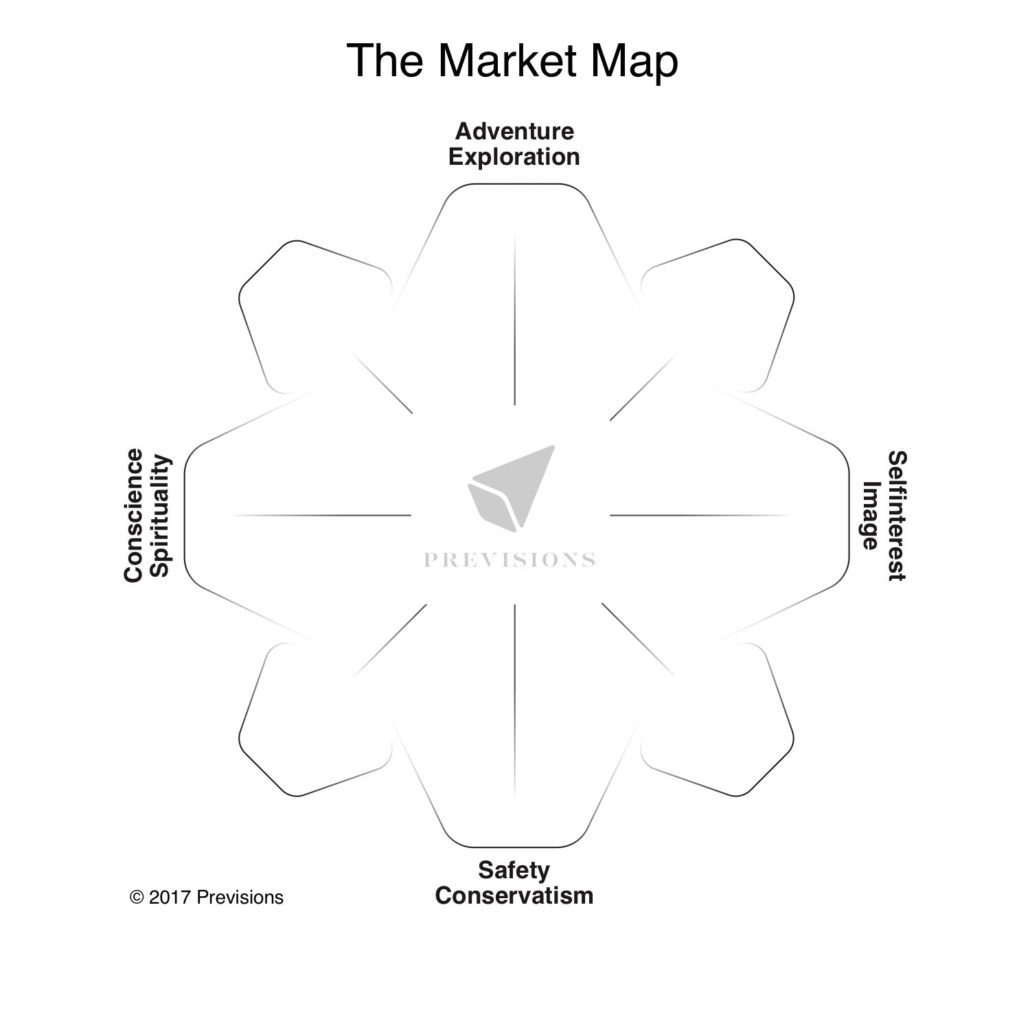
For a typical market you have people distributed everywhere on the map.
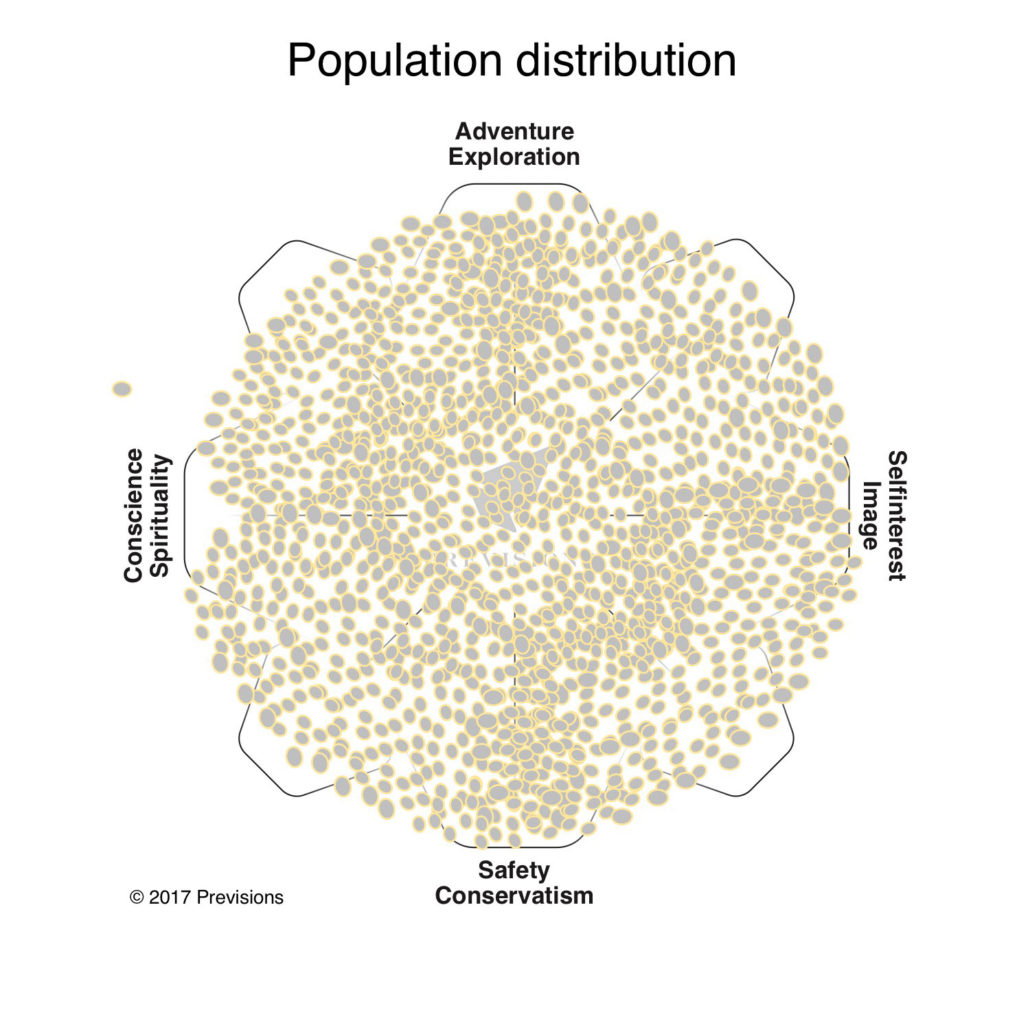
In simple terms 25 % of the population is found in each quadrant of the map. You will find the younger population dominating north east, and the older the south west. Others are distributed more or less all over.
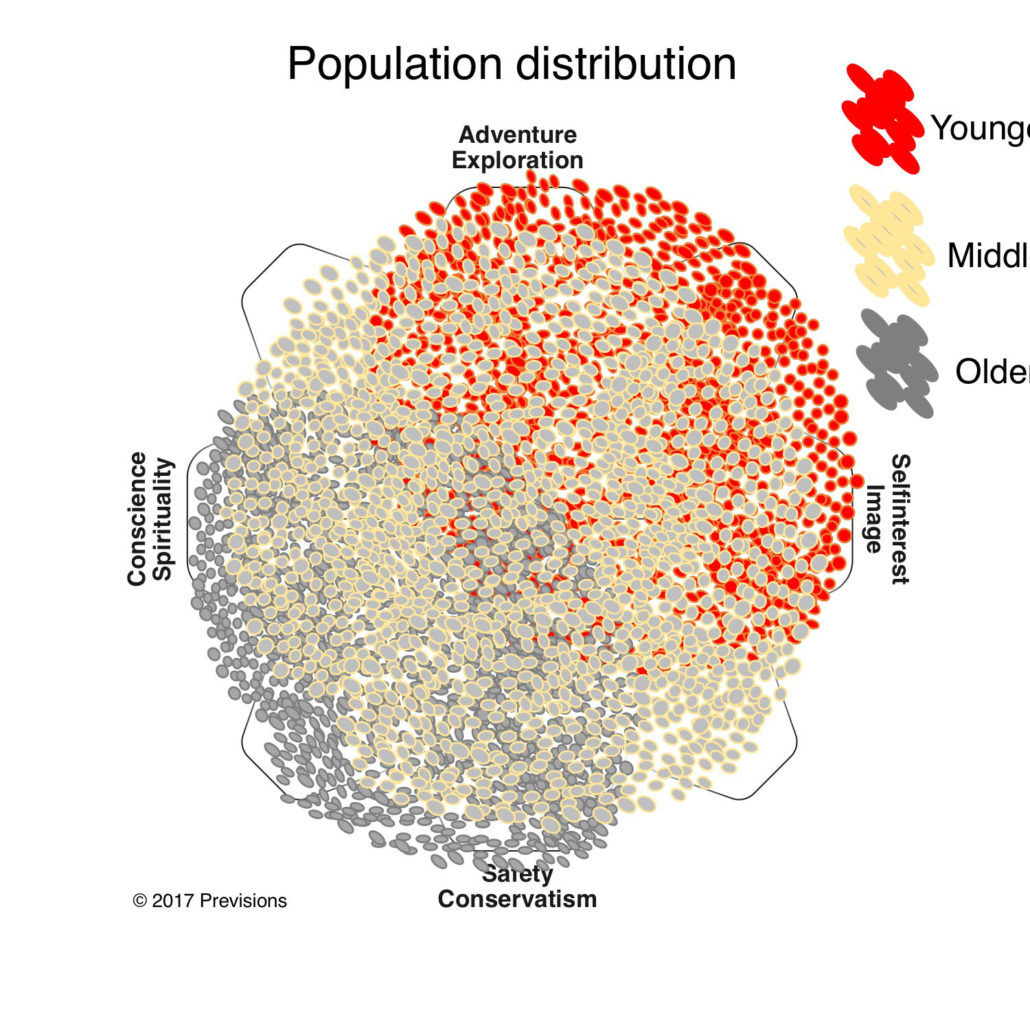
Geoffery Moore’s target for innovation “positive to change as well as innovation and who have flexible mindsets, eager to take the risks of being first to get the chance to harvest on the next exciting step” are found in the north.
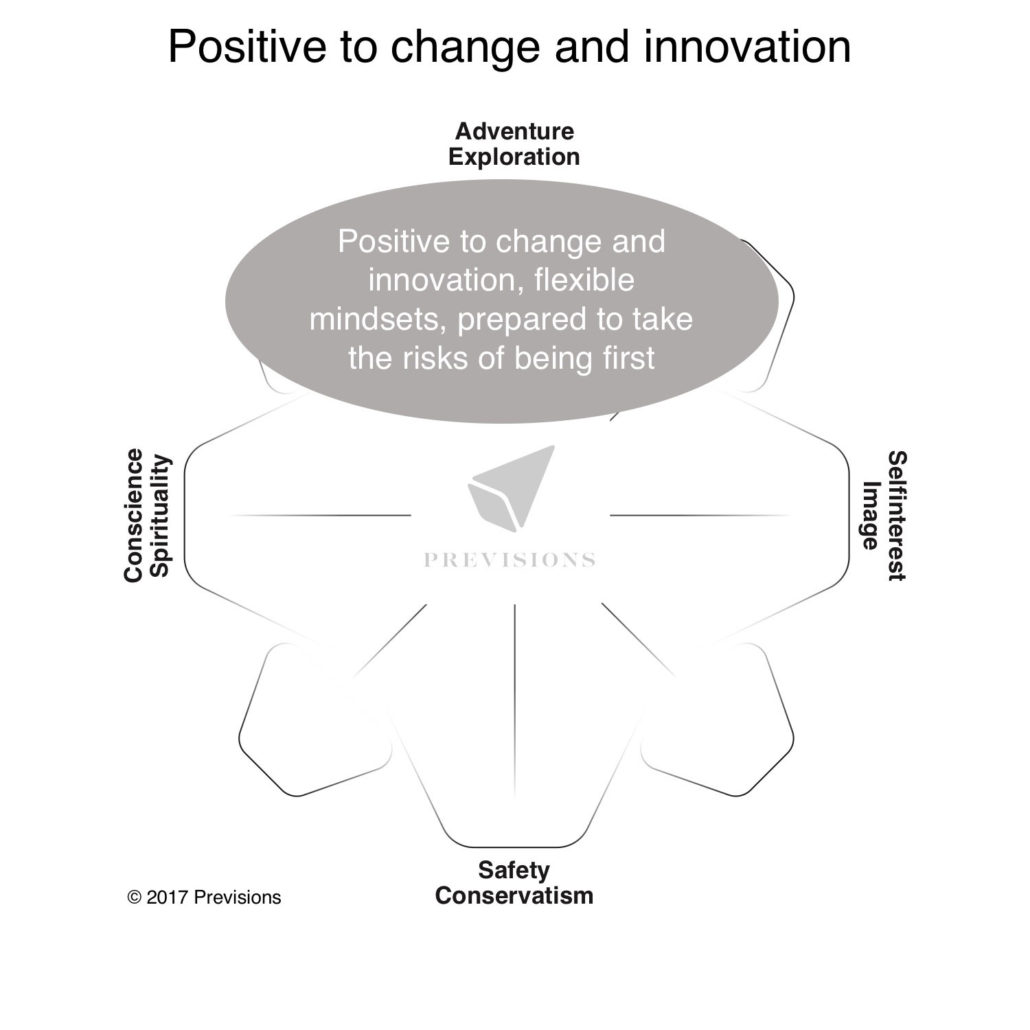
While innovative friendly customers are united by continuously looking for the latest are early adopters more diverse and divided. Some early adopters have high concerns for inclusive lasting benefits, convenience and sustainable solutions. These are found in the north west of the market map, where the grey and blue fields intersect.
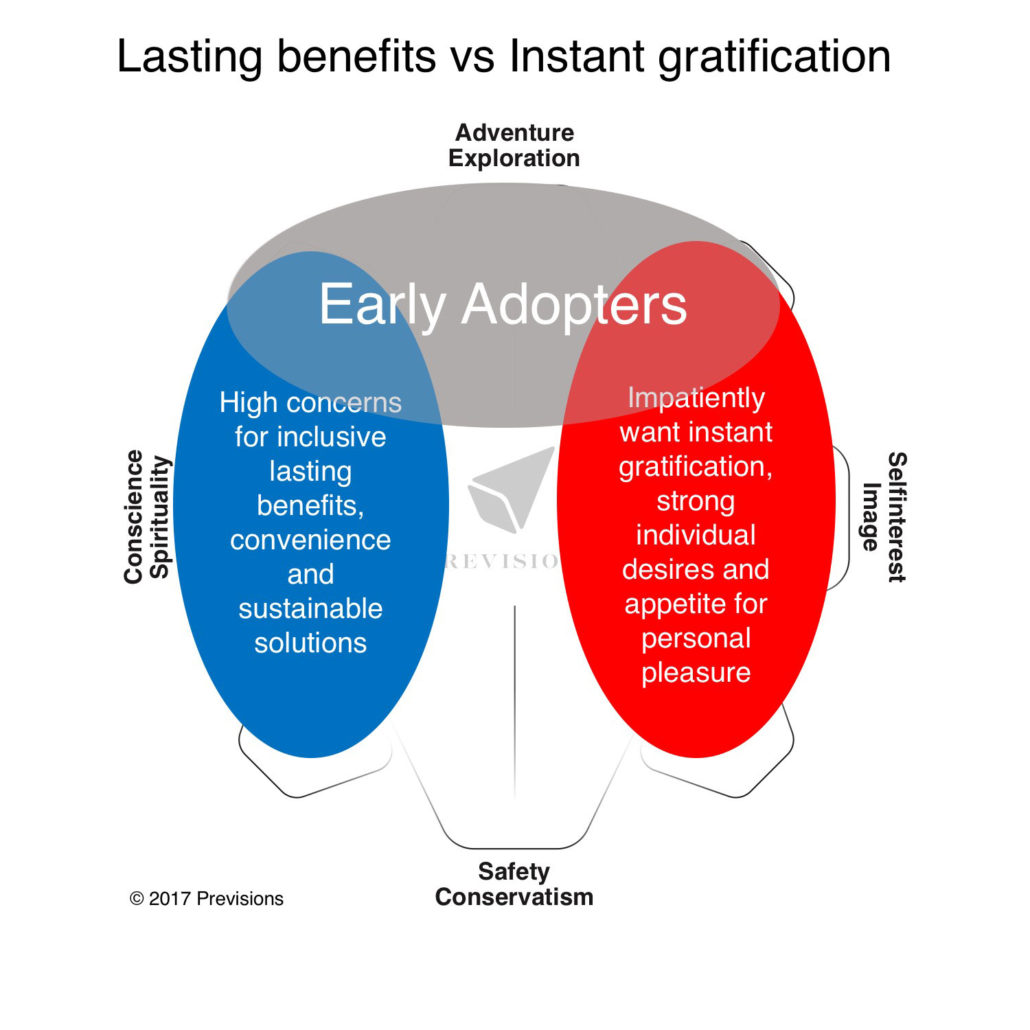
Other early adopters impatiently want instant gratification, have strong individual desires and healthy appetite for personal pleasure. These are found in the north east of the map, where the grey and red fields intersect.
North West of the Market Map is the natural start for adoption of completely new so far unknown TOOL concepts. The more utilitarian and the more revolutionary the more likely the first adopters of new infocom TOOLs will be found in North West. To increase likelihood of successful adoption the offer should be tailored for the TOOL adopters. This include product composition as well as marketing messages.
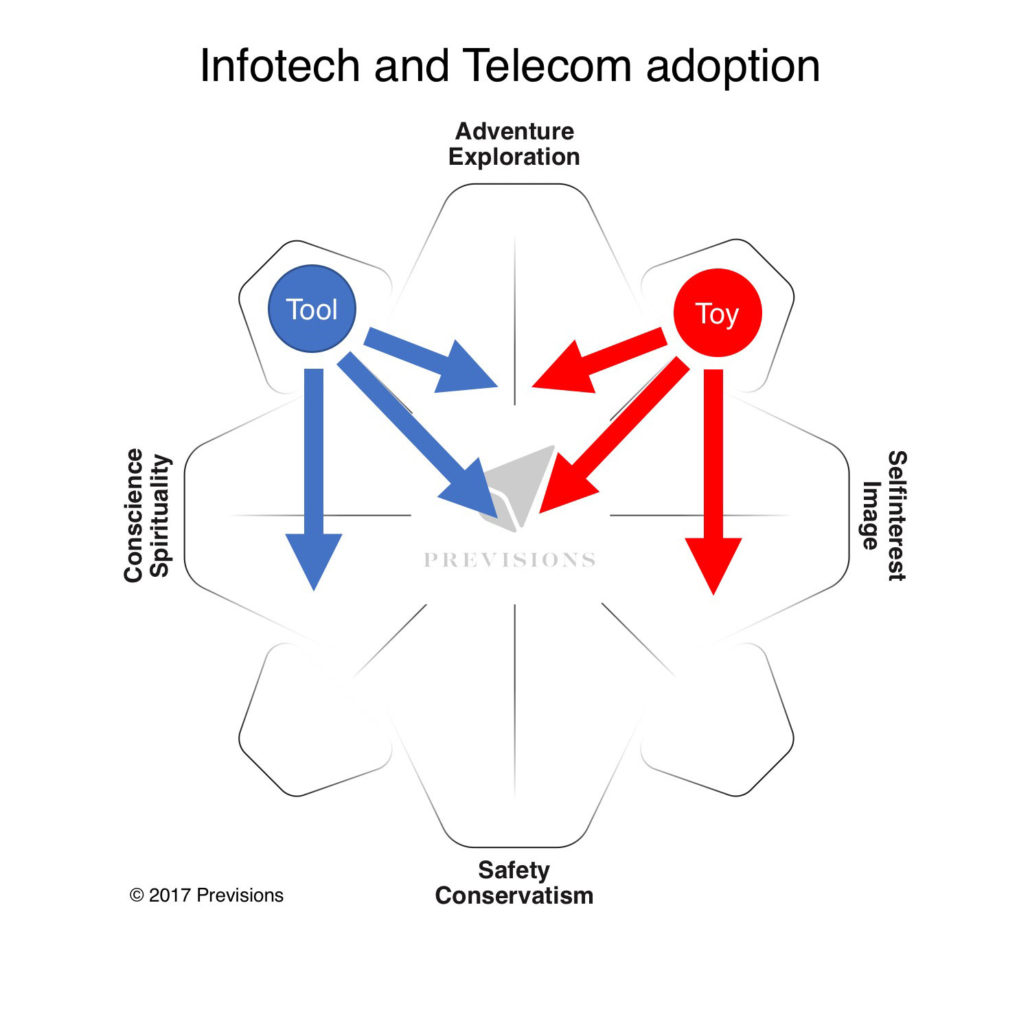
North East of the Market Map is on the other hand the natural start for adoption of completely new TOY concepts. The more revolutionary the more likely the first adopters of new infocom TOYs will be found in North East. In this case success comes from an offer tailored for the TOY adopters personality and needs.
While early adopter youth are dominated by a more immediate gratification toy desire are early adopter professionals more into utilities with lasting benefits.
As said, North East and North West of the Market Map are the natural start for adoption of completely new revolutionary and up till now unknow concepts. Let’s look at three concrete examples to further understand the adoption logic.
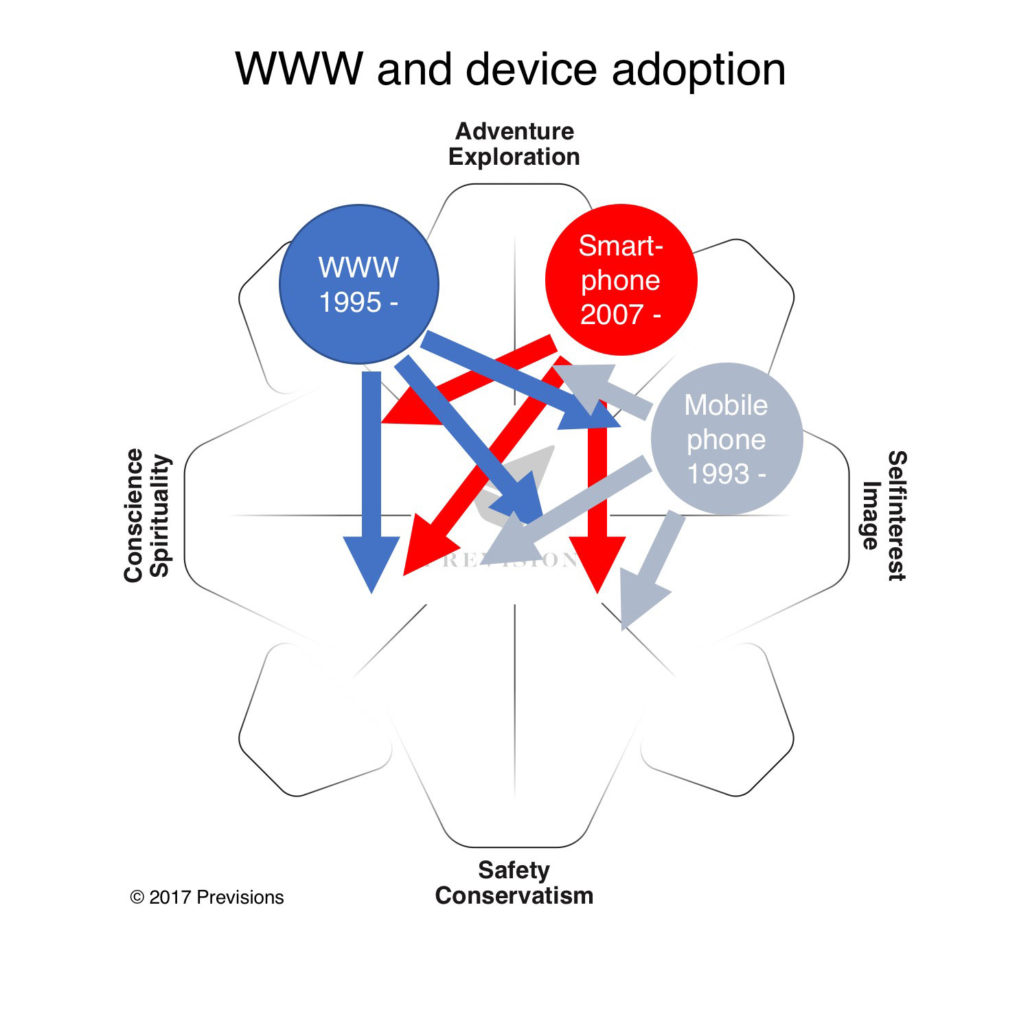
Case Mobile Phone adoption
When the mobile phone entered the market in the early 90s, adoption started in the very East of the Map.
This case immediately high-lighted the necessity of a solid analysis of a concept’s benefits and complexity before launching it into the market. To the market in the early 90s the mobile was just a small telephone without a cable. It didn’t require much imagination to understand the benefits, consequently a not so risky choice. Individualistic people with an impatient personality and/or mobile lifestyle/profession were eager to adopt to get instant benefits. Those mobiles were out of reach for youth, due to the very high prices of the phones. This further contributed to a more conservative early adopter than what is normal.
Case WWW adoption
When the first browsers, like Netscape, entered the market it was not instantly obvious how powerful these tools would be. However, knowledge and information hungry explorative people could imagine the potential. This was to them all facts and knowledge of the world at the finger tip envisioned. They also had the patience with early flaws as they wanted to be part of the journey into the future.
Case Smartphone adoption
iPhone was not the first smartphone on the market, but when it hit the market in 2007 it really personalised what is a playful infotech TOY. Where its predecessors had failed, it excelled. From one perspective the iPhone repeated the early 90s success of telephony in your pocket with the promise of internet in your pocket/purse. However, internet was at this time not as integrated in everybody’s life the way the 100 year old telephone had been. Internet usage had matured a lot since 1995, but it was still dominated by explorative people. It was also a very weak mobile internet connection that Apple provided initially, users had to rely mainly on wifi access. The success was instead very much about the amazing user experience. App store and Apple opening up for APPs from anyone and anywhere gave a further wow-factor and stimulated an idea-explosion. Multiple finger touch brought the instant gratification, colour screen and revolutionary design further added the pleasure. The APPs also enabled spontaneity in the complex contexts of mobile use cases. At the same time the concept still required significant imagination and wish to experiment from the users.
A utility future
After 20 years of device race, I believe times have come where early adopter with a more utilitarian motive gain influence over the toy early adopter not just for smartphone trends but telecom trends overall.
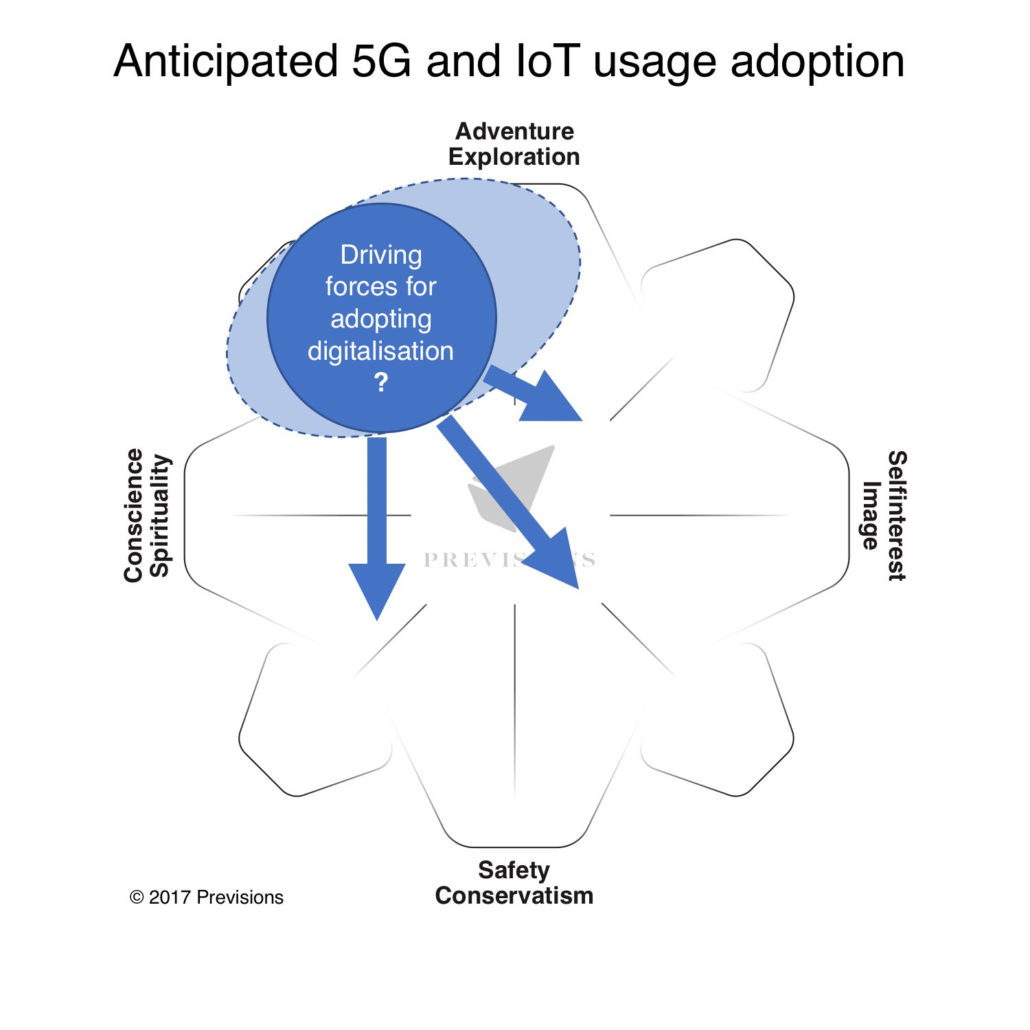
This drive comes from many forces
- On a macro level, the push comes from the desire for a more sustainable, inclusive and equal society.
- From technology development, 5G and internet of things will drive the whole mobile industry towards utilities of industrial automation and automation overall. Automation has never been about fancy instant gratification, but instead very much hardcore serious lasting benefits and cost savings.
- The increased bandwidth possible in 5G is likely beyond the smartphone and mobile lifestyle requirements and will rather be a utilitarian fibre replacement.
- With the increasing internalisation of smartphones in everyday life, they become too important to stay as toys, and both Internet and Apple are gradually sliding back to their origin of providing utility.
- A growing insight that the smartphone is an excellent foundation for utilitarian benefits of various kinds. APPs for Mobile banking, navigation, document scanning, train, flight tickets etc take more and more attention away from games.
Apple being stuck with an increasing utilitarian iPhone might not be what the shareholders want to hear, but it seems the likely future.
For industry, it means that it is time to go back to the functional logic before youth surprised us with their endless desire for personal mobile communication.
This thinking is kind of fascinating for me personally as I was one of those that fought hard to convince sceptic executives that youth and 3G were the future and that future phones will have other colours than black. After been interviewed by CNN as the crazy man believing in youth, I never thought that I had to say that youth importance going forward might be less, only 20 years later. Yes, youth is still important particularly in young economies, but less as the ultimate early adopter.
The from A to B future
So how big is the difference between tool logic and toy logic? It is as big as the difference between a Toyota and a BMW. As big as the difference between considering the smartest, safest, most convenient sustainable way to go from point A to point B, versus looking forward to a driving experience in the vehicle of ultimate performance. It is as big as the difference between sharing and owning. It is as big as the difference between blue and red. It is as big as the difference between saving and spending. It is as big as staying in control and let go.
Let’s stay with the difference of A to B transport versus the ultimate driving experience. People today buy cars for different reasons. Particularly premium car brands build their existence on differentiating their offering from the car as a utility.
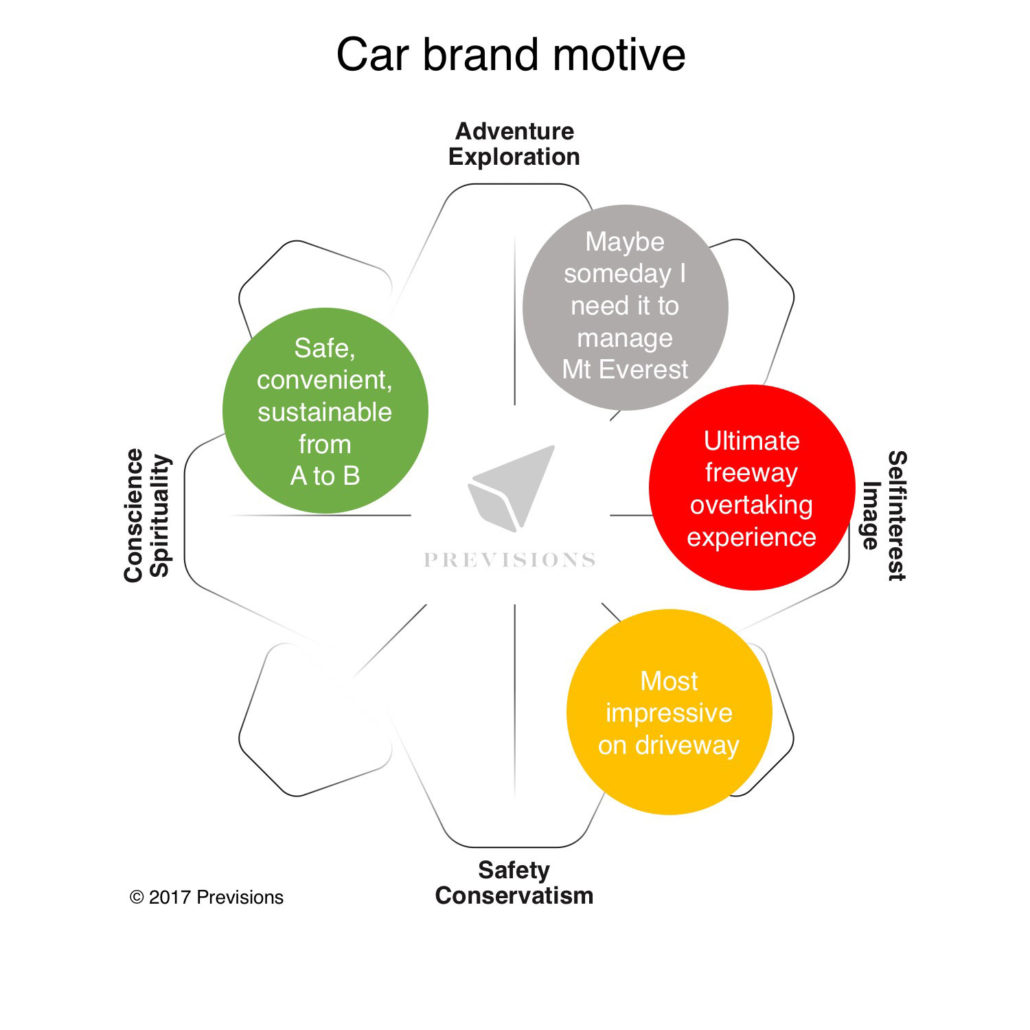
Self-driving cars will enter the market, no doubt. But how and by whom and for what reason? Imagine if society enforce the concept of self-driven shared cars as the main way forward. This makes a lot of sense from city planning and sustainability perspective. This would put everything in value creation upside down for basically all premium car brands.
- What should we help people impress with on the drive-way if they don’t own the car?
- How can people show that our cars have more muscles than other brands if people don’t have control of their cars?
- How can we help people to achieve their dreams and dare to grasp opportunities if the cars are not theirs?
Yes, indeed its exciting and revolutionary times, and if my hypothesis hold true:
- It will affect artificial intelligence (AI) and machine learning (ML) to rather be packaged as “Intelligence Amplification”, extending the information processing capabilities of the human mind rather than being autonomous smarties.
- It will affect Augmented Reality (AR) to give lasting benefits beyond exciting games.
- It will drive self-driving cars towards a public transport alternative. Yes, tech interested individualistic BMW buyers might still be the first to buy self-driving cars. However, are they the one’s that will give up their driving desires and let society’s sustainable point A to B public transport logic take command of their car?
- It will drive smartphones and apps towards ultimate simplicity and inclusiveness.
- The dominating use cases and form factors of smartphones are so high that significant contributions beyond simplicity, durability, reach and apps are unlikely.
Welcome to
- Our new guides into the future, the serious early adopter professional.
- The era where customer value comes from efficient, cost saving, conveniently digitised processes.
Goodbye to
- Margins and dominance from exciting technology per se.
Long live the Smartphone!

Henrik Pålsson
Chief Visionary Officer
Previsions AB







